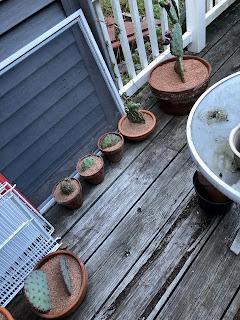 |
| A large opuntia in its nursery pot. |
Cacti are native to the Americas and are not found elsewhere. Succulents other than cacti are mostly native to Africa but some are found in the Middle East. The way to tell the difference is cacti have an areole (round feature on the surface) around each needle. Succulents often have needles but no areole. If you're not sure check the label or ask someone at the nursery.
The question we always get is “how are you going to get them back home?” That’s what this post is about.
First, the cactus must be bare rooted. Note that you can substitute “succulent” for “cactus” anywhere here.
 |
| Be sure to wear gloves at all times. |
 |
| The root ball often is not very large. |
 |
| Always have a supervisor. |
A cautionary word before proceeding: all cacti have needles or spikes. They also have what appear to be hairy spots. An opuntia is the best example of this. The “hairy” spots are placed regularly all over each “ear” of the cactus. But here’s the thing. They aren’t hairy. They’re tiny needles that will quickly get into your skin and are almost impossible to get out. Once they’re in there you might be able to pull them out by applying duct tape to the affected area and pulling it off quickly but that doesn’t work. The solution is to wear the heaviest gloves you can find. Welding gloves are good, as well as thick leather gardening gloves. You will probably still get stuck but not nearly as much.
Bare rooting is perfectly safe for the cactus because it is also a succulent and is basically a sponge. Knocking off most of the soil will greatly reduce the bulk of the pant as well as the weigh, which is significant. Once you knock off the initial amount soil you can massage the roots to get off more.
Sometimes with an opuntia you will need to twist off some of the upper ears because they are floppy or feel loose. Don't do it automatically. We did this with one. The cactus will grow new ones, and each ear will become a new cactus.
Once the soil is off, wrap the root ball fairly tightly. If it is small you can use a ziplock baggie. 1 or 2 gallons is generally ok.
Then wrap the body of the plant with cardboard then stretch wrap it in place. Then stretch wrap the whole thing. You’re done!
 |
| Wrap the body of the plant in cardboard. |
 |
| The soil removed from several cacti. We didn't have to ship it! |
Packing is important. We used a large moving box that is within the dimensions specified by the airline. In this case the requirement was that the package be less than 62” for combined height, length, and width. It also needed to be less than 50 pounds in weight. Use lightweight packing material such as empty water bottles to serve as air pillows, bubble wrap, or something that won’t add to the weight.
Seal the box and put your address and phone number on the top in case the box gets separated from your other checked luggage. On several sides including the top write “Fragile: Live plants” or something to that effect. On the vertical sides draw a big arrow pointing up to indicate the direction in which the box should be oriented.
You won’t be able to take the box as a carry on. You will need to check it. Be sure to ask at the curbside check in that they put a “fragile” sticker on it.
When you get home unpack the bus as soon as possible and pot up the cactus and enjoy! Be sure to keep your cacti and succulent outside until the temperatures start go go below 50 at night. When the temperature drops bring them inside and place in a sunny area. DO NOT WATER your cacti during the winter. They will be fine. They will go into dormancy and do not need water. Succulents are ok once a month for water when inside.
A word about repotting: use Turface MVP for your soil. You can often get it at landscaping companies. You can search online to find a dealer who carries it in your area. It comes in 40 lb. bags. It is crushed dry clay. It retains some moisture but freely drains water. Don't water a repotted cutting (one without roots) for a few weeks. If you do it won't be able to absorb the water and may rot.
In New England you shouldn't water a cactus more than once a week. If it rains sometime that week don't water. If your local forecast indicates several days of rain cover your cactus with plastic. Too much water might induce rot. Remember that the native environment of a cactus is an arid environment, or even a desert. Think of the body of the cactus as a sponge. It's already full of water.
Casualties of our packing: two small ears came off a smaller opuntia. Everything else was fine.
 |
| The above cactus in its new pot in CT |
 |
| Other cacti we brought home |
 |
| Other cacti we brought home |

No comments:
Post a Comment